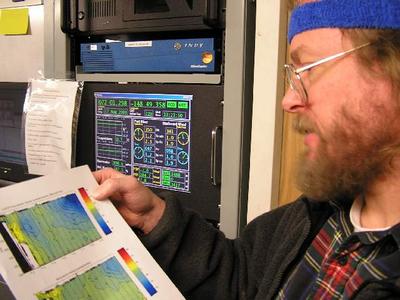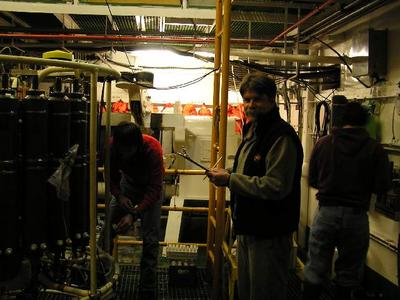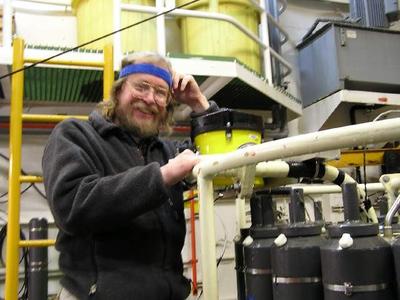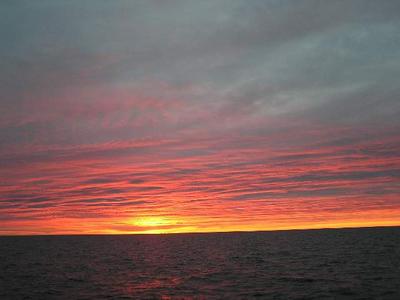17 August, 2003
The last cast and then we'll be done - at least that was the plan.
We're on station number 328 at 71.6 degrees north and 148.5 degrees west. It's also 4 am and although I completed my watch at midnight, I have stayed on to do the last station, for after all, when will I ever get to do this again? And it's a deep cast, which means it takes a few hours for the rosette to be lowered to 3375 meters, and then, raised to the surface, stopping 24 times at various depths to sample the water along the way.
The cast begins just like all the others. Nothing out of the ordinary until the rosette is a few hundred meters below the surface when suddenly all of the CTD sensor traces "flat line" across the computer screen. Monitoring the cast is Dr. Eric Johnson, who decides that the rosette must be retrieved, so he instructs the winch operator, Ric Tamayo, to bring it back. Once the array is up on deck in the Baltic Room, marine technicians Emily Constantine and Jesse Doren inspect the CTD probe and quickly discover that it has been "slimed," that is, a jellyfish has been sucked into its intake opening.
After thoroughly flushing the sensor's system, Emily, Jesse, and Ric repeat the process with Eric at the helm in the Forward Dry Lab. A few hours later, the rosette is back in the Baltic Room, and the night watch (and me) is on the scene to take a variety of water samples. Stephanie Moreland, Paul Ellis, Leopoldo Llinas, John Calderwood, and Kristin Sanborn, begin drawing dissolved oxygen, chlorophyll, salt, O18, and nutrient samples from the rosette as I record the essential data. Meanwhile, Eric attends to the Lowered Acoustic Doppler Current Profiler (LADCP) sensor, which he connects to a computer and downloads its data.
It's all just like the 327 times before. About an hour later, we're almost finished taking our samples, when Eric dashes back in. He hops up onto the rosette to ready the upper LADCP sensor, which is odd because this was our last station. He should be removing the probe from its mount on the array. What's more, there is a gleam in Eric's eye that you don't usually see on him or on anyone for that matter, at this hour in the morning.
When I finally catch up to Eric in the dry lab, he explains, "We're going to do another cast." Something must be up because Jim Swift is studying the LADCP data which is not an unusual sight, but I saw Jim goto bed hours ago. What Eric found was so interesting, in fact, that it was worth waking the chief scientist up in the wee hours of the morning.
Eric had detected a large river of water flowing westward at a rate of approximately 60 centimeters a second in the LADCP data. This came as a big surprise to everyone since it hadn't been seen before. Jim wondered allowed if this could be a new way of moving waters from the slope into the deep ocean basin? For obvious reasons, Eric and Jim quickly decided that it was worth moving the ship further along the section and performing one more cast- station 329.
Sure enought, the westward flowing current shows up again. What a way to end a cruise of discovery! But this goes to the heart of science; that is, each new finding points the way to future explorations.

1. The next to the last cast. The unusual color is the result of my camera's flash since it is finally getting dark at night.

2. Dr. Eric Johnson detects the westward flowing current in the LADCP data.

3. A tough sample cop directing the action on what was intended to be the cruise's last station. Leopoldo Llinas (left) and Paul Ellis are working in the background.

4. An excited oceanographer readies the Lowered Acoustic Doppler Current Profiler for one more cast of the rosette.

5. Paul celebrates the last cast in a "bath" of water from 3375 meters deep that measures a chilly minus 2 degrees Celsius.

6. Sunrise after the next to the last cast.
Contact the TEA in the field at
.
If you cannot connect through your browser, copy the
TEA's e-mail address in the "To:" line of
your favorite e-mail package.
|
